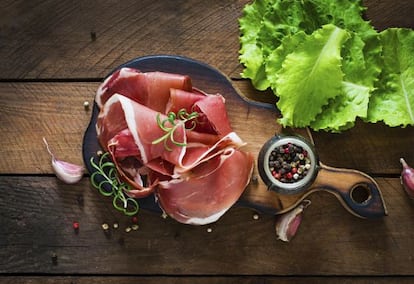How to look after your leg of ham
Three experts explain the best techniques for storing and serving your ‘jamón ibérico’

Taking the decision to give up foods as delicious as sausages and cured meats is no easy task. Although the World Health Organization (WHO) recently warned that such products can be carcinogenic, they’ve been with us all our lives, providing moments of intense pleasure.
With the world now separating into those embracing vegetarianism and those of us who would do anything to at least save jamón ibérico – the king of Spanish ham – from the witch-hunt, EL PAÍS spoke to three industry leaders to find out what unrepentant jamón eaters should do to select a quality product and handle it properly at home.
Here is the advice of Arturo Sánchez, heir to a veteran family business in Guijuelo (Salamanca); award-winning ham cutter Anselmo Pérez; and Josep Pedró, owner of the gourmet deli La Garriga.
Don’t keep that leg of ham in the kitchen, keep it in the living room
1. The perfect temperature. “It all depends whether the ham is freshly cut or vacuum packed. When it’s been pre-sliced, it should be consumed at a room temperature of 24ºC for all the quality to manifest itself,” says Arturo Sánchez. “Since the pack was probably inside the refrigerator at 2ºC to 4ºC, it is best to run it under hot water or leave it in a bowl of hot water until the fat becomes transparent. After that, let it sit for a minute before eating it. It will never taste like freshly sliced ham, but it will be 90 percent there.” Josep Pedró agrees, though he likes to leave it out of the fridge for an hour before eating.
2. Don’t leave it out too long. “From the moment it is sliced, if you are inside a room where the temperature is not above 25ºC, the ideal time to wait before eating it is 10 minutes. That’s if the ham is of good quality, because the fat becomes oxygenated and tastes better,” says Sánchez. If it is not so good, eat it fast, or it will dry out quickly because of the salt. “There are some types of ham that, after sitting on the plate for a while, start looking like a piece of cod and become inedible.”
3. Left leg or right leg? “There’s a lot of talk about the left leg of the pig being better than the right, but it’s not true. In theory this has to do with what side the animal sleeps on, based on the belief that the side that gets rested on more frequently will develop better. But animals alternate which side they sleep on, so there is absolutely no difference,” says Sánchez.

4. Is ham from female pigs better? Sánchez says that “this is another one of those long-held theories, and it is also not true. Male pigs that are raised for ham are castrated so they will not develop hormones such as testosterone, which does indeed play a role in fiber development.”
5. Sliced or cubed? Arturo Sánchez likes it both ways. “The way you cut it is the key. The slice has to be fine, nearly transparent, so you can put the whole thing in your mouth. But in order to get at all the leftover meat that’s stuck to the leg bone, it is best to make cubes.” Anselmo Pérez, who has won the Golden Knife Award for his ham-cutting skills on several occasions, adds a thought. “There are two parts that are typically used for cubes. One is the lean meat that sticks to the femur. This is the worst part of the ham, which is why it is cubed. The other one is the shanks, which have a lot of tendons and are hard to cut, and so you chop it into cubes when you don’t know how to slice it properly. We professionals slice it because this part has a special flavor, but people at home cube it, and it’s also very good that way.”
6. Use the proper knife. Master cutter Anselmo Pérez is crystal clear: “Not just any knife will do. If you want to do things right, one of the basic tools is a ham knife, which is long and flexible. […] We professional cutters have cases with 12 knives, but that’s another story...”
7. Forget about the white cloth. “When I walk into a restaurant or home and see a ham leg covered with just the typical white cloth, I feel sick. The best way to cover it is with its own fat, which you should not discard when you first start cutting into the leg. That way it does not oxidize and can easily last a month,” says Pérez. “What happens, though, is that after four of five days that piece of fat starts to oxidize and goes a bit rancid. That’s why the best thing to do is clean out the ham every time you cut it by eliminating parts of the outside rind. Even better, cover it tight in film wrap to keep the air out and prevent the oxidation process. After that you can put a cloth over it to protect it from sunlight.”
8. But definitely do use a white plate. Anselmo Pérez does not hesitate: “Always a white plate. It brings out the redness of the ham, while those little black slate trays stick to the fat and make it look transparent. Black slate is all very well for avant-garde cuisine, but not for ham.”
9. Ham with everything? “Ham combines better with certain drinks, like a good wine, of course. But I am not really fundamentalist over that issue, and I am very much in favor of new fads like having it with champagne or a gin and tonic. To each his own, as long as they enjoy it,” says Arturo Sánchez. But Josep Pedró disagrees: “I like it a lot better with white wine or champagne, because they cleanse your palate with each gulp and allow you to savor the ham again much more intensely.”

10. What does that black seal mean? “It means that the ham comes from a pure black Iberian pig. If it is not 100-percent black Iberian, the seal is red. Green is for jamón ibérico cebo de campo [crossbreeds that eat fodder but live in oak groves] and white is for jamón ibérico de cebo [crossbreeds that eat fodder and live in pens],” explains Sánchez. Jamón ibérico de bellota, ham from pure Iberian pigs that are part-fed on acorns, is the best there is.
11. Don’t keep it in the kitchen. “The truth is, the kitchen is not the best part of the house to keep a leg of ham, because it is often the hottest spot and a place where there are other smells that can affect the ham. That’s why, in most houses, it would be better to keep it in the living room,” says Josep Pedró.
12. Is it OK to have some bread with your ham? Josep Pedró is Catalan and so loves his pa amb tomàquet – a slice of bread topped with grated tomato and sometimes ham – but admits that the product is so good that it is best to simply eat it as you slice it. Arturo Sánchez and Anselmo Pérez also recommend eating it on its own.
13. What if I’m really bad with knives? If you don’t know how to slice your ham, rather than destroy it, consider taking it to a specialist. “A ham leg that’s been sliced open is worthless three months later,” explains Pedró. “Every year, people bring us more and more hams for us to slice for them. We slice them and place the slices in 100-gram or 250-gram vacuum packs that can last in perfect condition for up to a year and a half. We charge a fixed price of €35 for the cutting work and an additional 90 cents per pack.”
Black slate is all very well for avant-garde cuisine, but not for ham” Anselmo Pérez
14. Never throw away the bone. So the meat has been eaten and all that’s left is the bone. Don’t even think about throwing it away. “As all grandmothers know, you can make a good soup with the bone,” says Josep Pedró.
15. So can I feed my young nephew some ham? “Of course,” says Josep Pedró. “In my opinion, there is no particular age to start eating it. Ham is part of our culture and it has a lot of beneficial properties that have been scientifically proven, no matter what the WHO is saying now. In fact, it should clear up a lot of things, because its report left so many things up in the air that people are fortunately not taking it seriously. At least, we are not at all affected so far.” Arturo Sánchez could not agree more. “I grew up eating ham and other Iberian pork products such as salchichón and chorizo. I’ve done the same with my kids, and they are happy children.”
English version by Susana Urra.
Tu suscripción se está usando en otro dispositivo
¿Quieres añadir otro usuario a tu suscripción?
Si continúas leyendo en este dispositivo, no se podrá leer en el otro.
FlechaTu suscripción se está usando en otro dispositivo y solo puedes acceder a EL PAÍS desde un dispositivo a la vez.
Si quieres compartir tu cuenta, cambia tu suscripción a la modalidad Premium, así podrás añadir otro usuario. Cada uno accederá con su propia cuenta de email, lo que os permitirá personalizar vuestra experiencia en EL PAÍS.
¿Tienes una suscripción de empresa? Accede aquí para contratar más cuentas.
En el caso de no saber quién está usando tu cuenta, te recomendamos cambiar tu contraseña aquí.
Si decides continuar compartiendo tu cuenta, este mensaje se mostrará en tu dispositivo y en el de la otra persona que está usando tu cuenta de forma indefinida, afectando a tu experiencia de lectura. Puedes consultar aquí los términos y condiciones de la suscripción digital.
Archived In
Últimas noticias
How Japan is trying to avert ‘digital defeat’
From digital curfews to blocking apps: How technology experts protect their children online
Why the price of coffee has skyrocketed: from Brazilian plantations to specialty coffee houses
Confined to a Cuban hospital: When electricity is a matter of life or death
Most viewed
- Pablo Escobar’s hippos: A serious environmental problem, 40 years on
- Reinhard Genzel, Nobel laureate in physics: ‘One-minute videos will never give you the truth’
- Why we lost the habit of sleeping in two segments and how that changed our sense of time
- Charles Dubouloz, mountaineering star, retires at 36 with a farewell tour inspired by Walter Bonatti
- The Florida Keys tourist paradise is besieged by immigration agents: ‘We’ve never seen anything like this’








































